Paper Menu >>
Journal Menu >>
 Int. J. Communications, Network and System Sciences, 2009, 2, 836-844 doi:10.4236/ijcns.2009.29097 Published Online December 2009 (http://www.SciRP.org/journal/ijcns/). Copyright © 2009 SciRes. IJCNS Performance Analysis of an Optimal Circular 16-QAM for Wavelet Based OFDM Systems Khaizuran ABDULLAH, Seedahmed S. MAHMOUD*, Zahir M. HUSSAIN School of Electrical & Computer Engineering, RMIT University, Melbourne, Australia *Future Fiber Technologies Pty. Ltd., Mulgrave, Australia E-mail: khaizuran.abdullah@rmit.edu.au, smahmoud@fft.com.au, zmhussain@ieee.org Received August 20, 2009; revised September 29, 2009; accepted October 29, 2009 Abstract The BER performance for an optimal circular 16-QAM constellation is theoretically derived and applied in wavelet based OFDM system in additive white Gaussian noise channel. Signal point constellations have been discussed in much literature. An optimal circular 16-QAM is developed. The calculation of the BER is based on the four types of the decision boundaries. Each decision boundary is determined based on the space dis- tance d following the pdf Gaussian distribution with respect to the in-phase and quadrature components nI and nQ with the assumption that they are statistically independent to each other. The BER analysis for other circular M-ary QAM is also analyzed. The system is then applied to wavelet based OFDM. The wavelet transform is considered because it offers a better spectral containment feature compared to conventional OFDM using Fourier transform. The circular schemes are slightly better than the square schemes in most SNR values. All simulation results have met the theoretical calculations. When applying to wavelet based OFDM, the circular modulation scheme has also performed slightly less errors as compared to the square modulation scheme. Keywords: Performance OFDM, Fourier-Based OFDM, Wavelet-Based OFDM, Circular 16-QAM, Square 16-QAM 1. Introduction Quadrature amplitude modulation (QAM) is one of the most popular modulation schemes used by orthogonal frequency division multiplexing. Some popular types of M-ary QAM are 4-QAM, 16-QAM and 64-QAM. The number of 4, 16 and 64 is corresponding to 22, 24 and 26 in which that the superscript number 2, 4 or 6 is the bit rate per OFDM symbol respectively. In this paper, the constellation points derivation and the BER analysis are focused on 16-QAM, which gives an intermediate result of BER performance between 4- and 64-QAM in an AWGN channel [1]. The 16-QAM is also one of the standard modulation schemes in OFDMs’ applications such as terrestrial Digital Video Broadcasting (DVB), Digital Audio Broadcasting (DAB) and High Perform- ance Radio LAN Version 2 (HIPERLAN/2) [2]. In the transmitter, an OFDM symbol is mapped from binary to complex signal with amplitude and phase represented in real and imaginary number. On the other hand, the signal is demapped or extracted from complex signal to OFDM symbol in the receiver. The decision boundary is needed to detect the correct symbols between the transmitter and receiver. The bit error rate (BER) performance is deter- mined after performing the difference of errors between the transmitted bits with the received bits. The BER per- formance of M-ary QAM has been investigated by sev- eral authors. The exact BER expressions for QAM is presented in [3]. An extension of BER expressions con- sidering of an arbitrary constellation size is discussed in [4]. Both works include the square constellation points. In this paper, we propose an alternative BER expres- sion using optimal circular constellation points. The cal- culation of probability of error is based on determining the decision boundary. We have proposed four types of decision boundaries. Based on these types, the probability of error occurs when the receiver is making an incorrect decision. To the best of our knowledge, there is no work of the probabil- ity of error calculation for a circular 16-QAM with the application of wavelet-based OFDM, namely discrete wavelet transform (DWT). The principle feature of DWT is it has low pass and high pass filters satisfying perfect reconstruction property in the transmitter and receiver 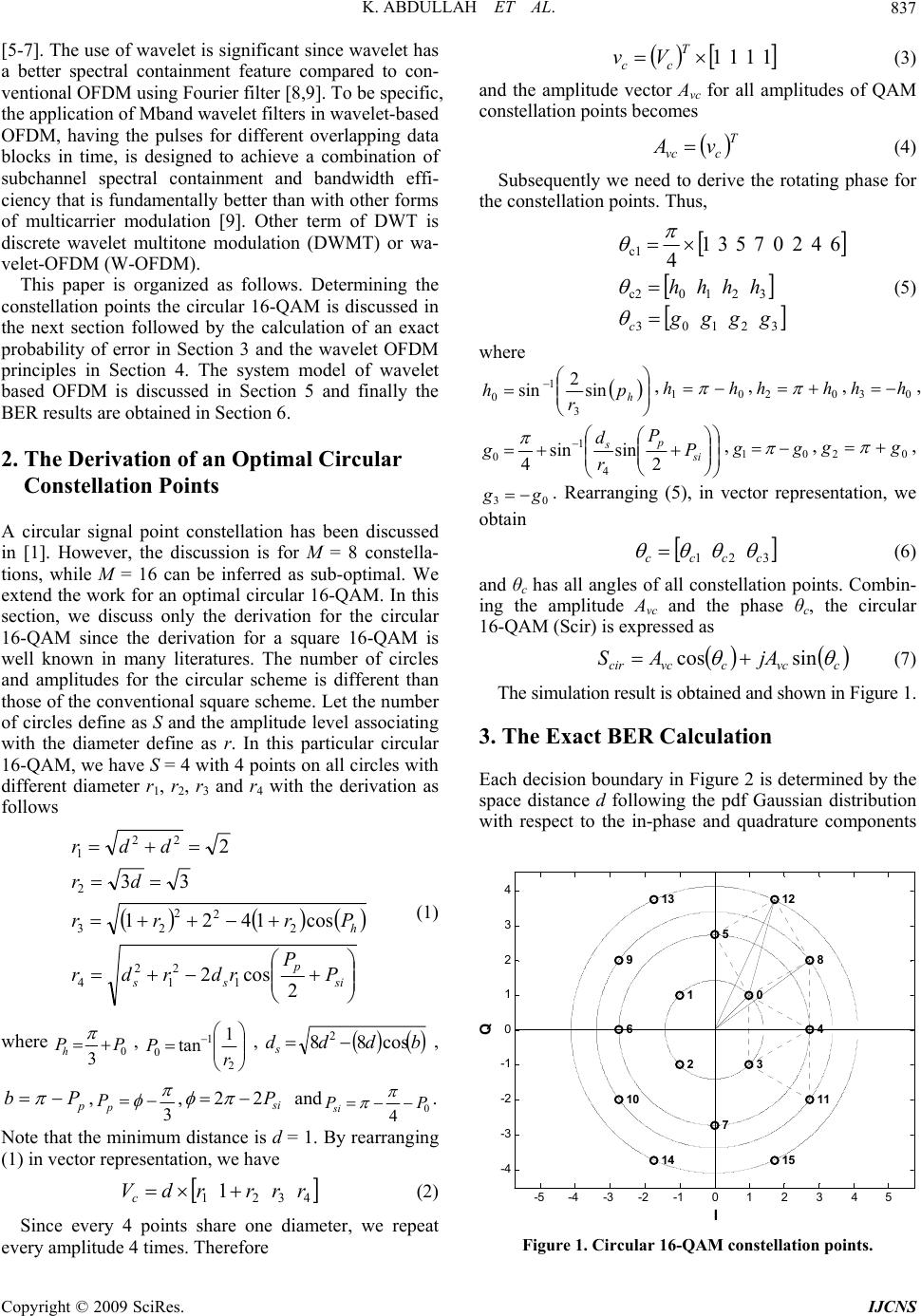 K. ABDULLAH ET AL. 837 [5-7]. The use of wavelet is significant since wavelet has a better spectral containment feature compared to con- ventional OFDM using Fourier filter [8,9]. To be specific, the application of Mband wavelet filters in wavelet-based OFDM, having the pulses for different overlapping data blocks in time, is designed to achieve a combination of subchannel spectral containment and bandwidth effi- ciency that is fundamentally better than with other forms of multicarrier modulation [9]. Other term of DWT is discrete wavelet multitone modulation (DWMT) or wa- velet-OFDM (W-OFDM). This paper is organized as follows. Determining the constellation points the circular 16-QAM is discussed in the next section followed by the calculation of an exact probability of error in Section 3 and the wavelet OFDM principles in Section 4. The system model of wavelet based OFDM is discussed in Section 5 and finally the BER results are obtained in Section 6. 2. The Derivation of an Optimal Circular Constellation Points A circular signal point constellation has been discussed in [1]. However, the discussion is for M = 8 constella- tions, while M = 16 can be inferred as sub-optimal. We extend the work for an optimal circular 16-QAM. In this section, we discuss only the derivation for the circular 16-QAM since the derivation for a square 16-QAM is well known in many literatures. The number of circles and amplitudes for the circular scheme is different than those of the conventional square scheme. Let the number of circles define as S and the amplitude level associating with the diameter define as r. In this particular circular 16-QAM, we have S = 4 with 4 points on all circles with different diameter r1, r2, r3 and r4 with the derivation as follows si p ss h P P rdrdr Prrr dr ddr 2 cos2 cos1421 33 2 1 2 1 2 4 2 2 2 23 2 22 1 (1) where 0 3PP h , 2 1 0 1 tan r P, bdddscos88 2 , p Pb , 3 p P,si P22 and0 4PP si . Note that the minimum distance is d = 1. By rearranging (1) in vector representation, we have 4321 1rrrrdVc (2) Since every 4 points share one diameter, we repeat every amplitude 4 times. Therefore 1111 T cc Vv (3) and the amplitude vector Avc for all amplitudes of QAM constellation points becomes T cvcvA (4) Subsequently we need to derive the rotating phase for the constellation points. Thus, 32103 3210c2 c1 64207531 4 gggg hhhh c (5) where h p r hsin 2 sin 3 1 0,01hh ,02 hh ,03hh , si pP P 21 g s r d gsinsin 44 1 0 , , 0 g 2 g0 g , 03 gg . Rearranging (5), in vector representation, we obtain 321cccc (6) and θc has all angles of all constellation points. Combin- ing the amplitude Avc and the phase θc, the circular 16-QAM (Scir) is expressed as cvccvccir jAAS sincos (7) The simulation result is obtained and shown in Figure 1. 3. The Exact BER Calculation Each decision boundary in Figure 2 is determined by the space distance d following the pdf Gaussian distribution with respect to the in-phase and quadrature components -5 -4 -3 -2 -1 0 1234 5 -4 -3 -2 -1 0 1 2 3 4 0 1 2 3 4 5 6 7 8 9 10 11 12 13 14 15 I Q Figure 1. Circular 16-QAM constellation points. Copyright © 2009 SciRes. IJCNS 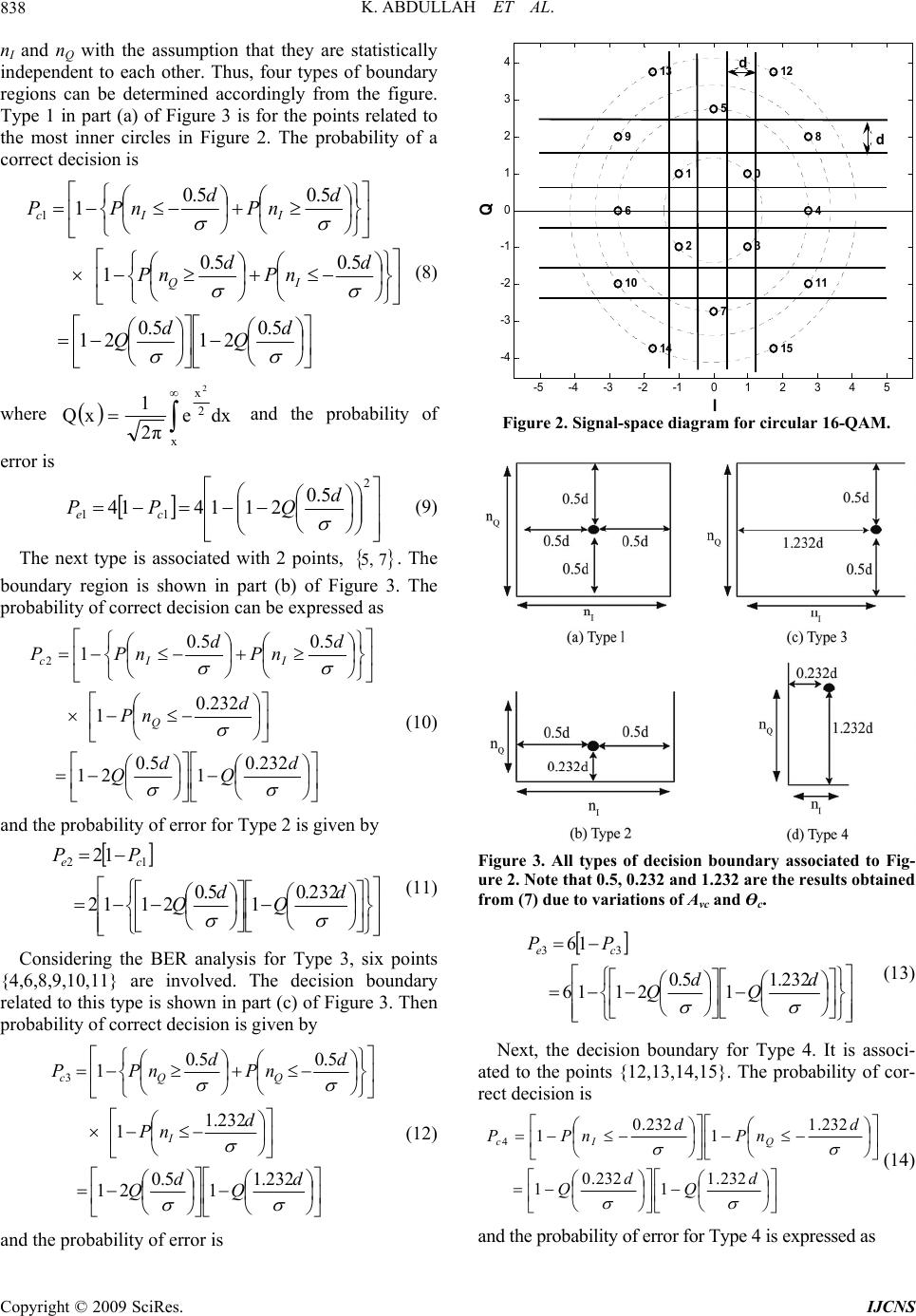 K. ABDULLAH ET AL. 838 nI and nQ with the assumption that they are statistically independent to each other. Thus, four types of boundary regions can be determined accordingly from the figure. Type 1 in part (a) of Figure 3 is for the points related to the most inner circles in Figure 2. The probability of a correct decision is d Q d Q d nP d nP d nP d nPP IQ IIc 5.0 21 5.0 21 5.05.0 1 5.05.0 1 1 (8) where x 2 x dxe 2π 1 xQ 2 and the probability of error is 2 11 5.0 211414 d QPP ce (9) The next type is associated with 2 points, 75,. The boundary region is shown in part (b) of Figure 3. The probability of correct decision can be expressed as d Q d Q d nP d nP d nPP Q IIc 232.0 1 5.0 21 232.0 1 5.05.0 1 2 (10) and the probability of error for Type 2 is given by d Q d Q PP ce 232.0 1 5.0 2112 12 12 (11) Considering the BER analysis for Type 3, six points {4,6,8,9,1 0,11} are involved. The decision boundary related to this type is shown in part (c) of Figure 3. Then probability of correct decision is given by d Q d Q d nP d nP d nPP I QQc 232.1 1 5.0 21 232.1 1 5.05.0 1 3 (12) and the probability of error is -5 -4 -3 -2 -1012 345 -4 -3 -2 -1 0 1 2 3 4 0 1 2 3 4 5 6 7 8 9 10 11 12 13 14 15 I Q d d Figure 2. Signal-space diagram for circular 16-QAM. Figure 3. All types of decision boundary associated to Fig- ure 2. Note that 0.5, 0.232 and 1.232 are the results obtained from (7) due to variations of Avc and Өc. d Q d Q PP ce 232.1 1 5.0 2116 16 33 (13) Next, the decision boundary for Type 4. It is associ- ated to the points {12,13,14,15}. The probability of cor- rect decision is d Q d Q d nP d nPPQIc 232.1 1 232.0 1 232.1 1 232.0 1 4 (14) and the probability of error for Type 4 is expressed as Copyright © 2009 SciRes. IJCNS 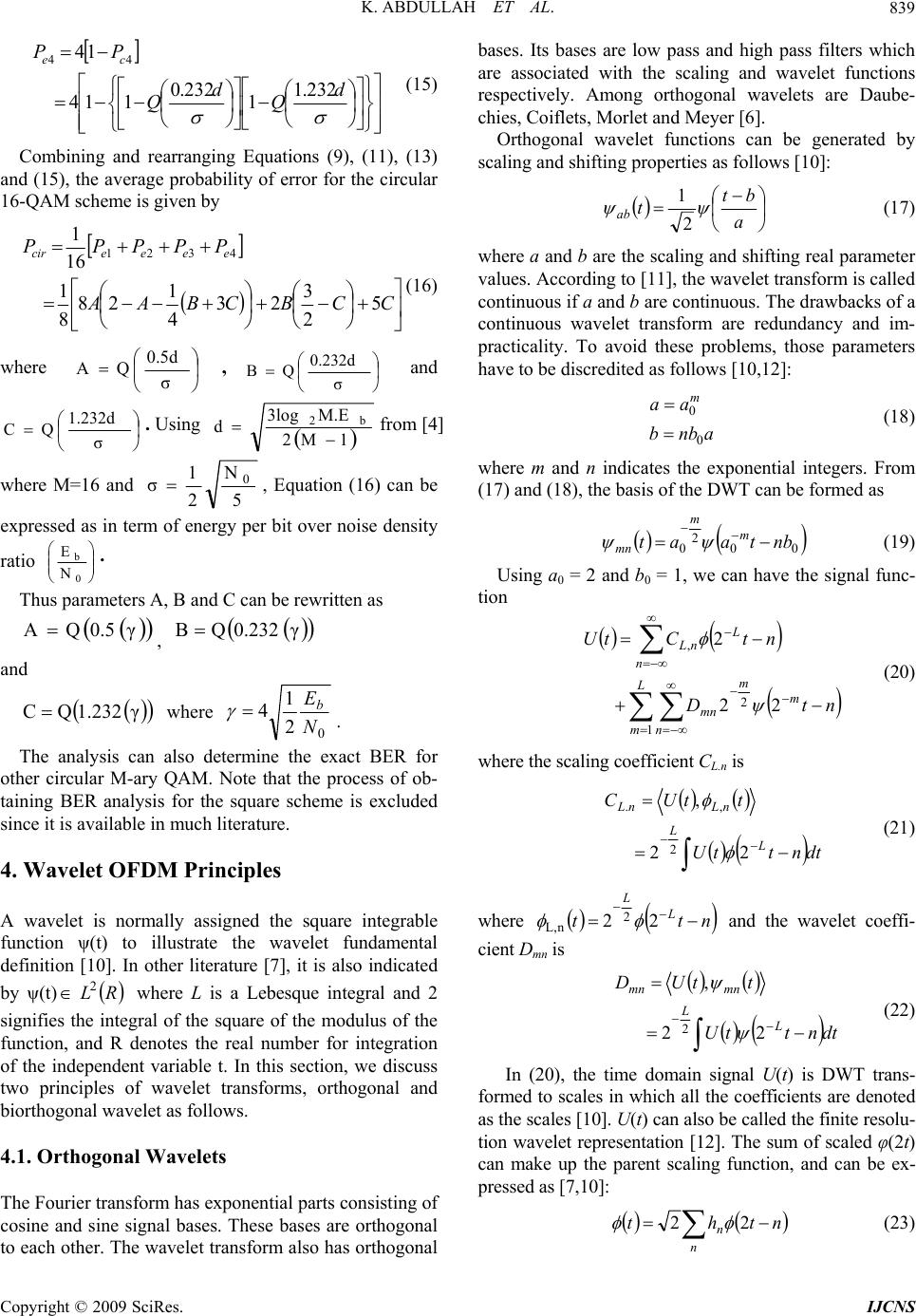 K. ABDULLAH ET AL. 839 d Q d Q PPce 232.1 1 232.0 114 14 44 (15) Combining and rearranging Equations (9), (11), (13) and (15), the average probability of error for the circular 16-QAM scheme is given by CCBCBAA PPPPPeeeecir 5 2 3 23 4 1 28 8 1 16 1 4321 (16) where σ 0.5d QA , σ 0.232d QB and σ 1.232d QC . Using 1M2 M.E3log db2 from [4] where M=16 and 5 N 2 1 σ0 , Equation (16) can be expressed as in term of energy per bit over noise density ratio 0 b N E. Thus parameters A, B and C can be rewritten as γ0.5QA , γ0.232QB and γ1.232QC where 0 2 1 4N Eb . The analysis can also determine the exact BER for other circular M-ary QAM. Note that the process of ob- taining BER analysis for the square scheme is excluded since it is available in much literature. 4. Wavelet OFDM Principles A wavelet is normally assigned the square integrable function ψ(t) to illustrate the wavelet fundamental definition [10]. In other literature [7], it is also indicated by ψ(t) where L is a Lebesque integral and 2 signifies the integral of the square of the modulus of the function, and R denotes the real number for integration of the independent variable t. In this section, we discuss two principles of wavelet transforms, orthogonal and biorthogonal wavelet as follows. RL2 4.1. Orthogonal Wavelets The Fourier transform has exponential parts consisting of cosine and sine signal bases. These bases are orthogonal to each other. The wavelet transform also has orthogonal bases. Its bases are low pass and high pass filters which are associated with the scaling and wavelet functions respectively. Among orthogonal wavelets are Daube- chies, Coiflets, Morlet and Meyer [6]. Orthogonal wavelet functions can be generated by scaling and shifting properties as follows [10]: a bt t ab 2 1 (17) where a and b are the scaling and shifting real parameter values. According to [11], the wavelet transform is called continuous if a and b are continuous. The drawbacks of a continuous wavelet transform are redundancy and im- practicality. To avoid these problems, those parameters have to be discredited as follows [10,12]: anbb aa m 0 0 (18) where m and n indicates the exponential integers. From (17) and (18), the basis of the DWT can be formed as (19) 00 2 0nbtaat m m mn Using a0 = 2 and b0 = 1, we can have the signal func- tion L mn m m mn n L nL ntD ntCtU 1 2 , 22 2 (20) where the scaling coefficient CL.n is dtnttU ttUC L L nLnL 22 , 2 ,. (21) where nttL L 222 nL, and the wavelet coeffi- cient Dmn is dtnttU ttUD L L mnmn 22 , 2 (22) In (20), the time domain signal U(t) is DWT trans- formed to scales in which all the coefficients are denoted as the scales [10]. U(t) can also be called the finite resolu- tion wavelet representation [12]. The sum of scaled φ(2t) can make up the parent scaling function, and can be ex- pressed as [7,10]: n nntht 22 (23) Copyright © 2009 SciRes. IJCNS 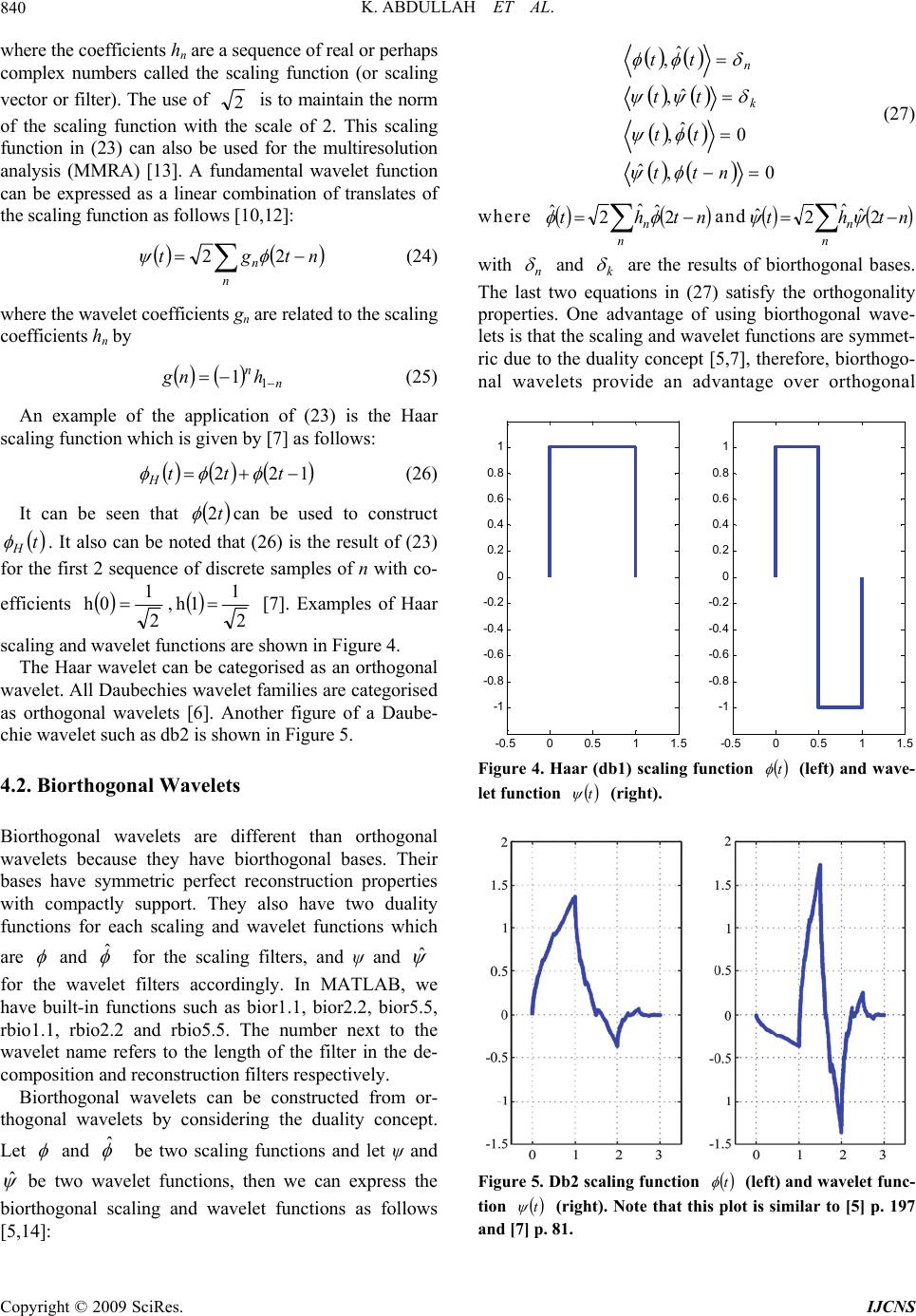 K. ABDULLAH ET AL. 840 where the coefficients hn are a sequence of real or perhaps complex numbers called the scaling function (or scaling vector or filter). The use of 2 is to maintain the norm of the scaling function with the scale of 2. This scaling function in (23) can also be used for the multiresolution analysis (MMRA) [13]. A fundamental wavelet function can be expressed as a linear combination of translates of the scaling function as follows [10,12]: n nntgt 22 (24) where the wavelet coefficients gn are related to the scaling coefficients hn by n nhng 1 1 (25) An example of the application of (23) is the Haar scaling function which is given by [7] as follows: 122 ttt H (26) It can be seen that t2 can be used to construct t H . It also can be noted that (26) is the result of (23) for the first 2 sequence of discrete samples of n with co- efficients 2 1 0h , 2 1 1h [7]. Examples of Haar scaling and wavelet functions are shown in Figure 4. The Haar wavelet can be categorised as an orthogonal wavelet. All Daubechies wavelet families are categorised as orthogonal wavelets [6]. Another figure of a Daube- chie wavelet such as db2 is shown in Figure 5. 4.2. Biorthogonal Wavelets Biorthogonal wavelets are different than orthogonal wavelets because they have biorthogonal bases. Their bases have symmetric perfect reconstruction properties with compactly support. They also have two duality functions for each scaling and wavelet functions which are and for the scaling filters, and ψ and ˆ ˆ for the wavelet filters accordingly. In MATLAB, we have built-in functions such as bior1.1, bior2.2, bior5.5, rbio1.1, rbio2.2 and rbio5.5. The number next to the wavelet name refers to the length of the filter in the de- composition and reconstruction filters respectively. Biorthogonal wavelets can be constructed from or- thogonal wavelets by considering the duality concept. Let and be two scaling functions and let ψ and ˆ ˆbe two wavelet functions, then we can express the biorthogonal scaling and wavelet functions as follows [5,14]: 0, ˆ 0 ˆ , ˆ , ˆ , ntt tt tt tt k n (27) where n nntht 2 ˆ ˆ 2 ˆ and n nntht 2 ˆ ˆ 2 ˆ with n and k are the results of biorthogonal bases. The last two equations in (27) satisfy the orthogonality properties. One advantage of using biorthogonal wave- lets is that the scaling and wavelet functions are symmet- ric due to the duality concept [5,7], therefore, biorthogo- nal wavelets provide an advantage over orthogonal -0.5 00.5 11.5 -1 -0. 8 -0. 6 -0. 4 -0. 2 0 0.2 0.4 0.6 0.8 1 -0.5 00.5 11.5 -1 -0.8 -0.6 -0.4 -0.2 0 0.2 0.4 0.6 0.8 1 Figure 4. Haar (db1) scaling function (left) and wave- let function t t (right). Figure 5. Db2 scaling function (left) and wavelet func- tion t t (right). Note that this plot is similar to [5] p. 197 and [7] p. 81. Copyright © 2009 SciRes. IJCNS 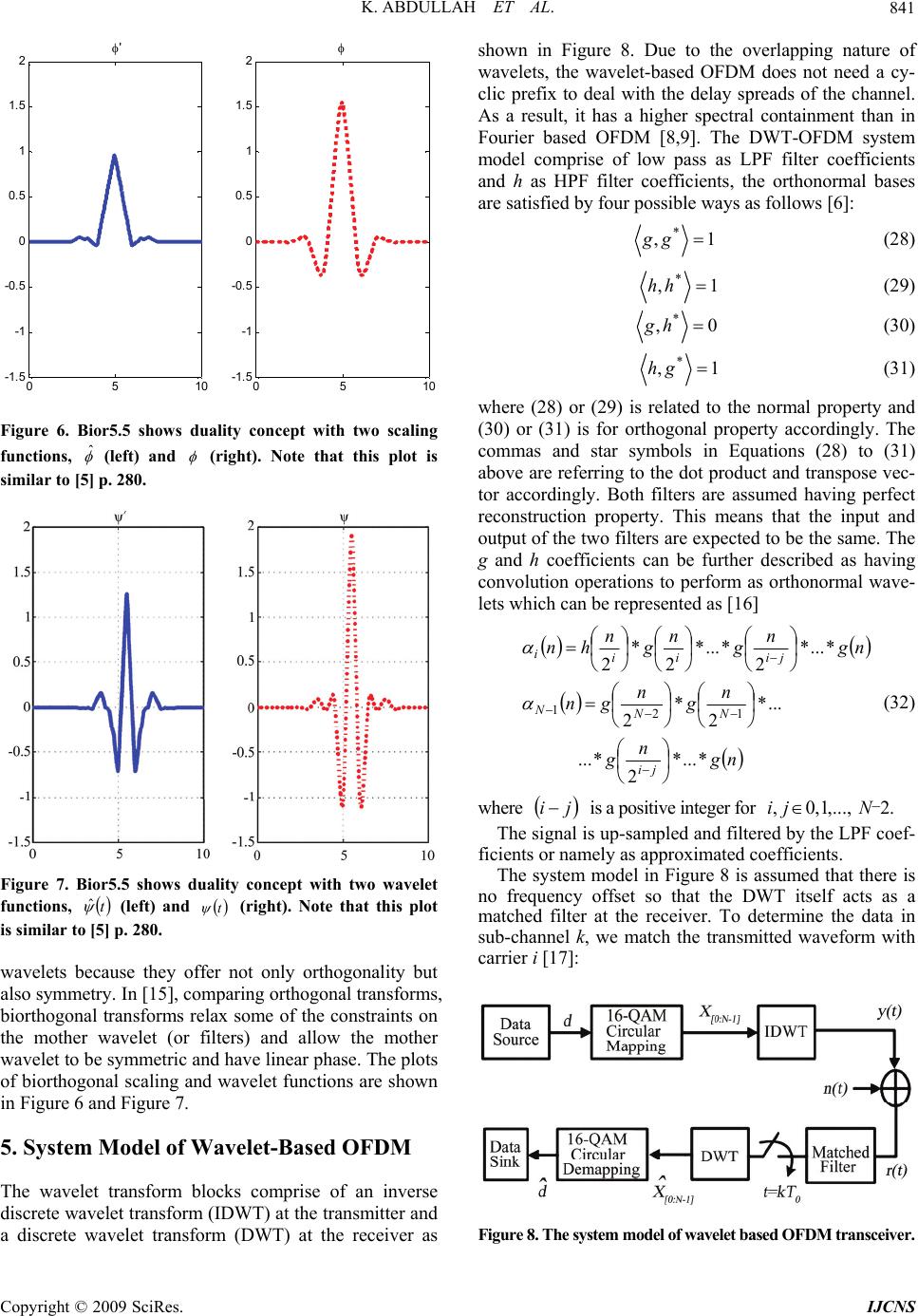 K. ABDULLAH ET AL. 841 05 10 -1.5 -1 -0.5 0 0.5 1 1.5 2 ' 05 10 -1.5 -1 -0.5 0 0.5 1 1.5 2 Figure 6. Bior5.5 shows duality concept with two scaling functions, (left) and ˆ (right). Note that this plot is similar to [5] p. 280. Figure 7. Bior5.5 shows duality concept with two wavelet functions, (left) and (right). Note that this plot is similar to [5] p. 280. t ˆ t wavelets because they offer not only orthogonality but also symmetry. In [15], comparing orthogonal transforms, biorthogonal transforms relax some of the constraints on the mother wavelet (or filters) and allow the mother wavelet to be symmetric and have linear phase. The plots of biorthogonal scaling and wavelet functions are shown in Figure 6 and Figure 7. 5. System Model of Wavelet-Based OFDM The wavelet transform blocks comprise of an inverse discrete wavelet transform (IDWT) at the transmitter and a discrete wavelet transform (DWT) at the receiver as shown in Figure 8. Due to the overlapping nature of wavelets, the wavelet-based OFDM does not need a cy- clic prefix to deal with the delay spreads of the channel. As a result, it has a higher spectral containment than in Fourier based OFDM [8,9]. The DWT-OFDM system model comprise of low pass as LPF filter coefficients and h as HPF filter coefficients, the orthonormal bases are satisfied by four possible ways as follows [6]: 1, *gg (28) 1, *hh (29) 0,*hg (30) 1, *gh (31) where (28) or (29) is related to the normal property and (30) or (31) is for orthogonal property accordingly. The commas and star symbols in Equations (28) to (31) above are referring to the dot product and transpose vec- tor accordingly. Both filters are assumed having perfect reconstruction property. This means that the input and output of the two filters are expected to be the same. The g and h coefficients can be further described as having convolution operations to perform as orthonormal wave- lets which can be represented as [16] ng n g n g n gn ng n g n g n hn ji NN N jiii i *...* 2 *... ...* 2 * 2 *...* 2 *...* 2 * 2 12 1 (32) where ji is a positive integer for N-2. ,...,1,0, ji The signal is up-sampled and filtered by the LPF coef- ficients or namely as approximated coefficients. The system model in Figure 8 is assumed that there is no frequency offset so that the DWT itself acts as a matched filter at the receiver. To determine the data in sub-channel k, we match the transmitted waveform with carrier i [17]: Figure 8. The system model of wavelet based OFDM transceiver. Copyright © 2009 SciRes. IJCNS 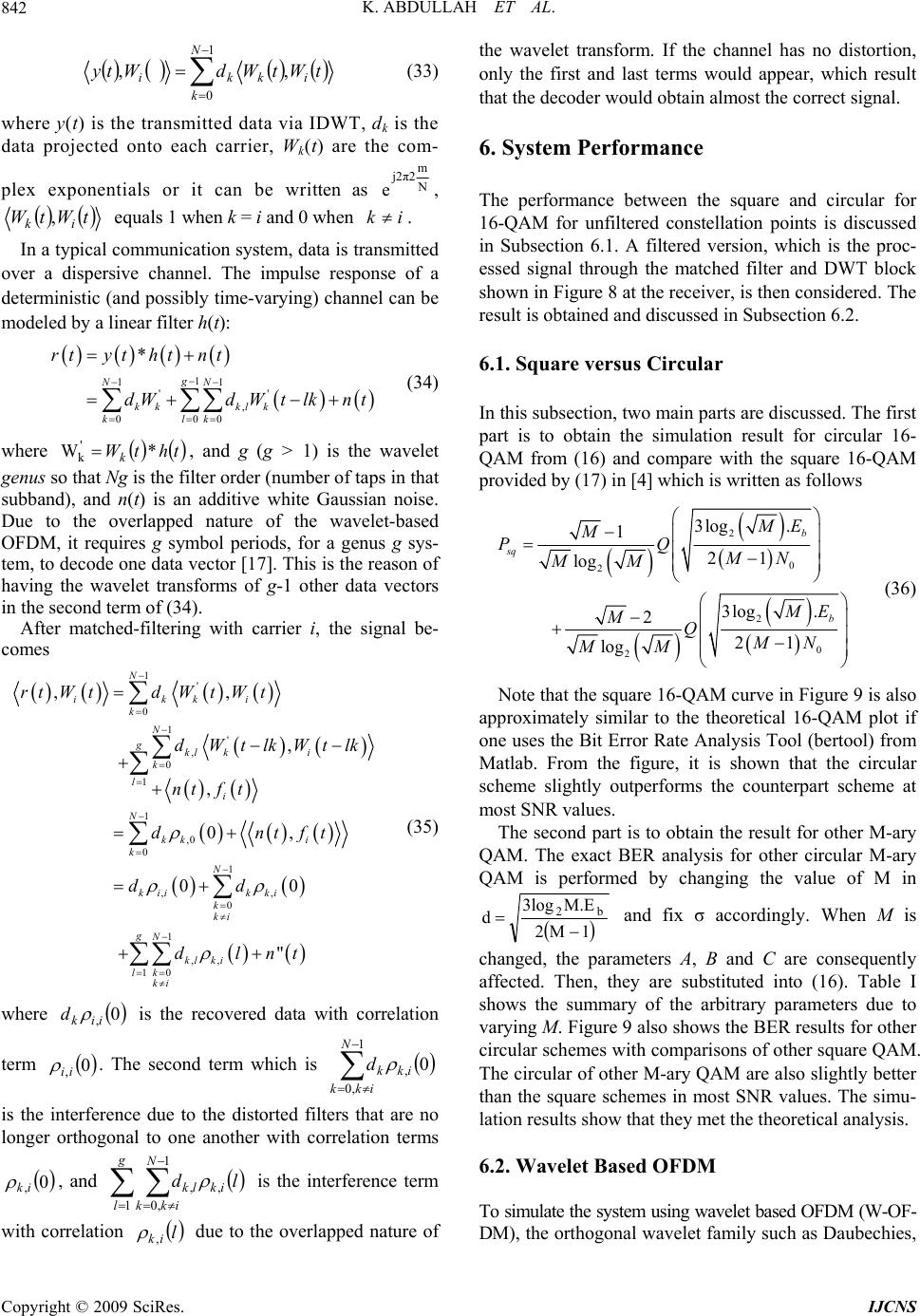 K. ABDULLAH ET AL. 842 1 0 ,, N k ikki tWtWdWty (33) where y(t) is the transmitted data via IDWT, dk is the data projected onto each carrier, Wk(t) are the com- plex exponentials or it can be written as N m j2π2 e, tWtW ik , equals 1 when k = i and 0 when ik . In a typical communication system, data is transmitted over a dispersive channel. The impulse response of a deterministic (and possibly time-varying) channel can be modeled by a linear filter h(t): 1 11 '' , 000 * g NN kk klk klk rtyt htnt dWdWtlknt (34) where , and g (g > 1) is the wavelet genus so that Ng is the filter order (number of taps in that subband), and n(t) is an additive white Gaussian noise. Due to the overlapped nature of the wavelet-based OFDM, it requires g symbol periods, for a genus g sys- tem, to decode one data vector [17]. This is the reason of having the wavelet transforms of g-1 other data vectors in the second term of (34). thtWk*W' k After matched-filtering with carrier i, the signal be- comes 1 ' 0 1 ' , 0 1 1 ,0 0 1 ,, 0 1 ,, 10 ,, , , 0, 00 " N ikki k N gkl ki k l i N kk i k N kii kki k ki gN kl ki lk ki rtW tdWtW t d WtlkWtlk ntft dntft dd dlnt (35) where 0 ,iik d is the recovered data with correlation term 0 ,ii . The second term which is is the interference due to the distorted filters that are no longer orthogonal to one another with correlation terms 1 ,0 ,0 N ikk ikk d 0 ,ik , and is the interference term with correlation N ikk iklk ld 1 ,0 ,, l ik , g l1 due to the overlapped nature of the wavelet transform. If the channel has no distortion, only the first and last terms would appear, which result that the decoder would obtain almost the correct signal. 6. System Performance The performance between the square and circular for 16-QAM for unfiltered constellation points is discussed in Subsection 6.1. A filtered version, which is the proc- essed signal through the matched filter and DWT block shown in Figure 8 at the receiver, is then considered. The result is obtained and discussed in Subsection 6.2. 6.1. Square versus Circular In this subsection, two main parts are discussed. The first part is to obtain the simulation result for circular 16- QAM from (16) and compare with the square 16-QAM provided by (17) in [4] which is written as follows 2 0 2 2 0 2 3log. 1 21 log 3log . 2 21 log b sq b ME M PQ MN MM ME MQMN MM (36) Note that the square 16-QAM curve in Figure 9 is also approximately similar to the theoretical 16-QAM plot if one uses the Bit Error Rate Analysis Tool (bertool) from Matlab. From the figure, it is shown that the circular scheme slightly outperforms the counterpart scheme at most SNR values. The second part is to obtain the result for other M-ary QAM. The exact BER analysis for other circular M-ary QAM is performed by changing the value of M in 1M2 M.E3log db2 and fix σ accordingly. When M is changed, the parameters A, B and C are consequently affected. Then, they are substituted into (16). Table I shows the summary of the arbitrary parameters due to varying M. Figure 9 also shows the BER results for other circular schemes with comparisons of other square QAM. The circular of other M-ary QAM are also slightly better than the square schemes in most SNR values. The simu- lation results show that they met the theoretical analysis. 6.2. Wavelet Based OFDM To simulate the system using wavelet based OFDM (W-OF- DM), the orthogonal wavelet family such as Daubechies, Copyright © 2009 SciRes. IJCNS 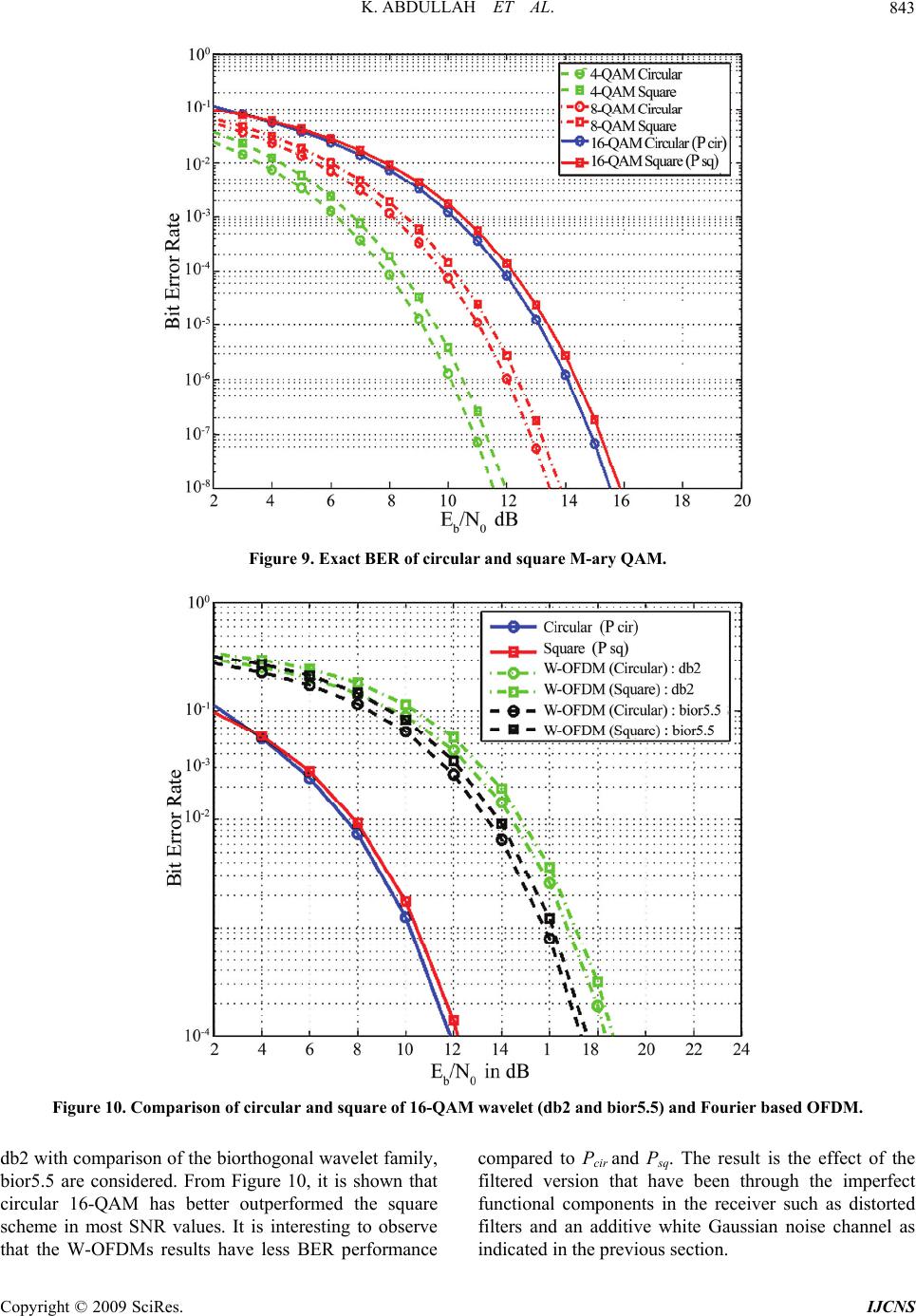 K. ABDULLAH ET AL. Copyright © 2009 SciRes. IJCNS 843 Figure 9. Exact BER of circular and square M-ary QAM. Figure 10. Comparison of circular and square of 16-QAM wavelet (db2 and bior5.5) and Fourier based OFDM. db2 with comparison of the biorthogonal wavelet family, bior5.5 are considered. From Figure 10, it is shown that circular 16-QAM has better outperformed the square scheme in most SNR values. It is interesting to observe that the W-OFDMs results have less BER performance compared to Pcir and Psq. The result is the effect of the filtered version that have been through the imperfect functional components in the receiver such as distorted filters and an additive white Gaussian noise channel as indicated in the previous section. 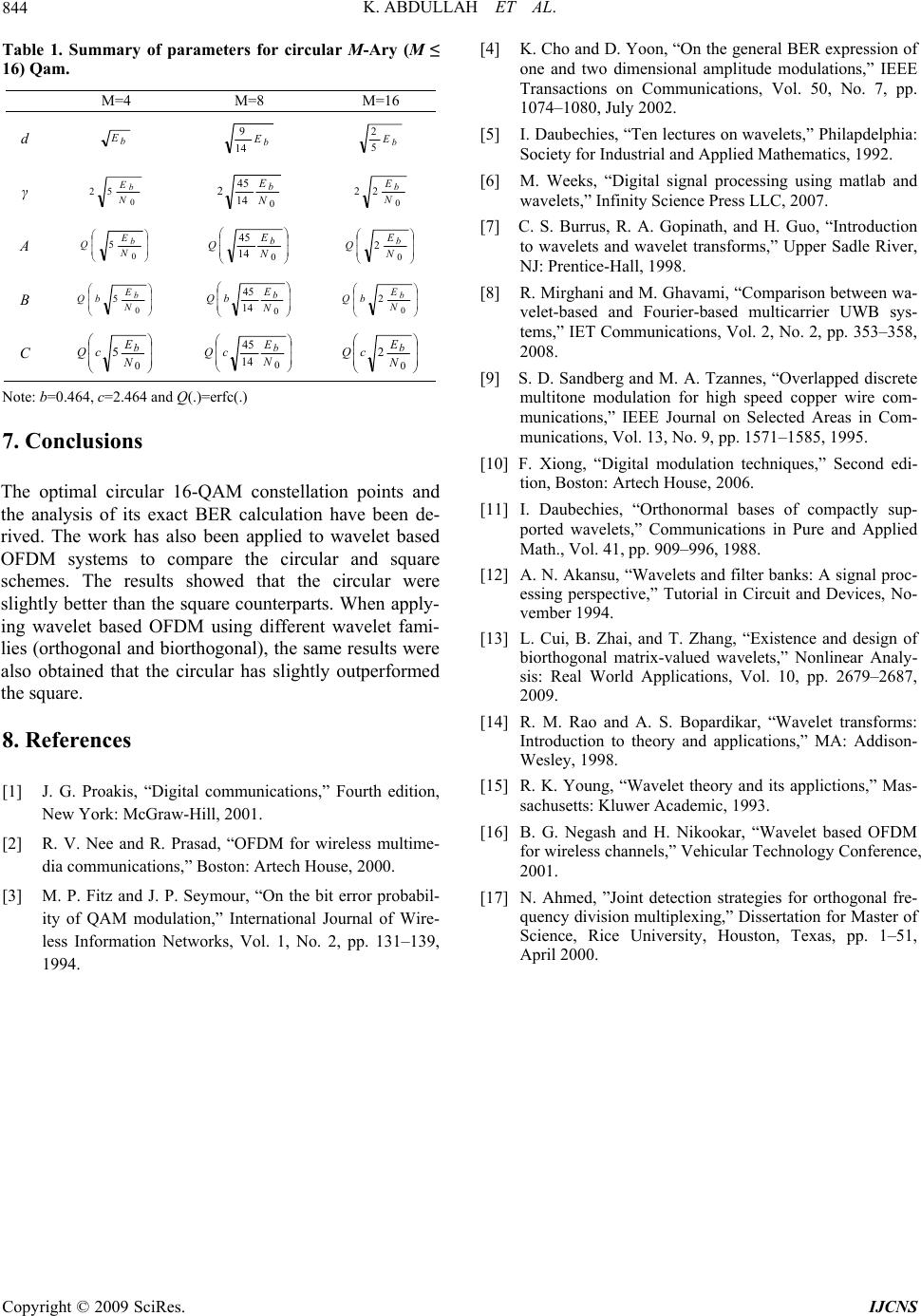 K. ABDULLAH ET AL. 844 Table 1. Summary of parameters for circular M-Ary (M ≤ 16) Qam. M=4 M=8 M=16 d b E b E 14 9 b E 5 2 γ 0 52N Eb 0 14 45 2N Eb 0 22 N Eb A 0 5N E Qb 0 14 45 N E Qb 0 2N E Qb B 0 5N E bQ b 0 14 45 N E bQ b 0 2N E bQ b C 0 5N E cQ b 0 14 45 N E cQ b 0 2N E cQ b Note: b=0.464, c=2.464 and Q(.)=erfc(.) 7. Conclusions The optimal circular 16-QAM constellation points and the analysis of its exact BER calculation have been de- rived. The work has also been applied to wavelet based OFDM systems to compare the circular and square schemes. The results showed that the circular were slightly better than the square counterparts. When apply- ing wavelet based OFDM using different wavelet fami- lies (orthogonal and biorthogonal), the same results were also obtained that the circular has slightly outperformed the square. 8. References [1] J. G. Proakis, “Digital communications,” Fourth edition, New York: McGraw-Hill, 2001. [2] R. V. Nee and R. Prasad, “OFDM for wireless multime- dia communications,” Boston: Artech House, 2000. [3] M. P. Fitz and J. P. Seymour, “On the bit error probabil- ity of QAM modulation,” International Journal of Wire- less Information Networks, Vol. 1, No. 2, pp. 131–139, 1994. [4] K. Cho and D. Yoon, “On the general BER expression of one and two dimensional amplitude modulations,” IEEE Transactions on Communications, Vol. 50, No. 7, pp. 1074–1080, July 2002. [5] I. Daubechies, “Ten lectures on wavelets,” Philapdelphia: Society for Industrial and Applied Mathematics, 1992. [6] M. Weeks, “Digital signal processing using matlab and wavelets,” Infinity Science Press LLC, 2007. [7] C. S. Burrus, R. A. Gopinath, and H. Guo, “Introduction to wavelets and wavelet transforms,” Upper Sadle River, NJ: Prentice-Hall, 1998. [8] R. Mirghani and M. Ghavami, “Comparison between wa- velet-based and Fourier-based multicarrier UWB sys- tems,” IET Communications, Vol. 2, No. 2, pp. 353–358, 2008. [9] S. D. Sandberg and M. A. Tzannes, “Overlapped discrete multitone modulation for high speed copper wire com- munications,” IEEE Journal on Selected Areas in Com- munications, Vol. 13, No. 9, pp. 1571–1585, 1995. [10] F. Xiong, “Digital modulation techniques,” Second edi- tion, Boston: Artech House, 2006. [11] I. Daubechies, “Orthonormal bases of compactly sup- ported wavelets,” Communications in Pure and Applied Math., Vol. 41, pp. 909–996, 1988. [12] A. N. Akansu, “Wavelets and filter banks: A signal proc- essing perspective,” Tutorial in Circuit and Devices, No- vember 1994. [13] L. Cui, B. Zhai, and T. Zhang, “Existence and design of biorthogonal matrix-valued wavelets,” Nonlinear Analy- sis: Real World Applications, Vol. 10, pp. 2679–2687, 2009. [14] R. M. Rao and A. S. Bopardikar, “Wavelet transforms: Introduction to theory and applications,” MA: Addison- Wesley, 1998. [15] R. K. Young, “Wavelet theory and its applictions,” Mas- sachusetts: Kluwer Academic, 1993. [16] B. G. Negash and H. Nikookar, “Wavelet based OFDM for wireless channels,” Vehicular Technology Conference, 2001. [17] N. Ahmed, ”Joint detection strategies for orthogonal fre- quency division multiplexing,” Dissertation for Master of Science, Rice University, Houston, Texas, pp. 1–51, April 2000. Copyright © 2009 SciRes. IJCNS |

